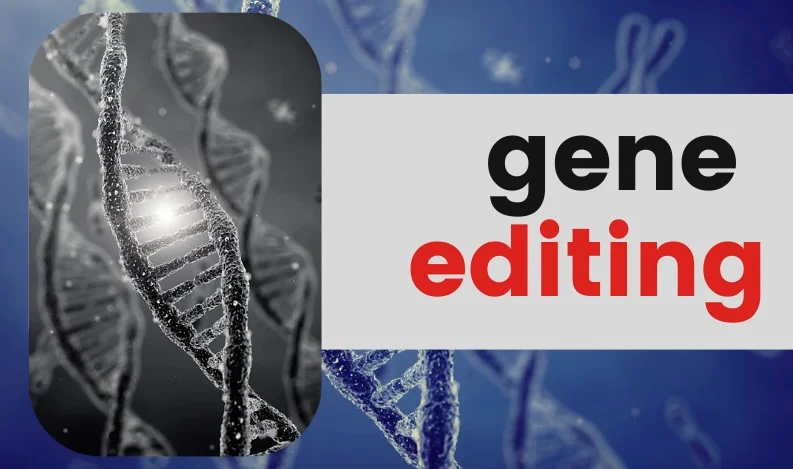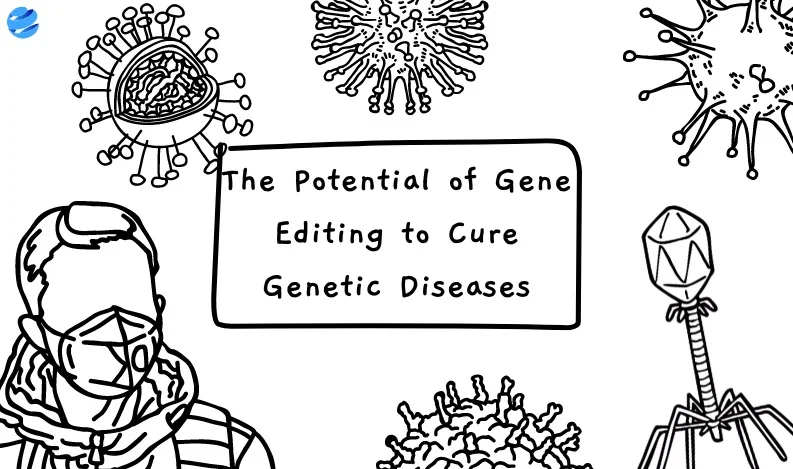Gene editing is a groundbreaking science. It allows us to alter our DNA, the genetic code in our cells that dictates how our bodies grow and function. Sometimes, errors in this code can lead to genetic diseases. Gene editing offers the potential to correct these errors, providing hope for curing many such conditions. In this blog, we will explore gene editing, its benefits, challenges, real-life examples, and the future possibilities it holds.
What is Gene Editing?
Understanding DNA
Our body comprises trillions of cells, each containing DNA. DNA, or deoxyribonucleic acid, acts like an instruction manual, guiding the growth, repair, and maintenance of our body. DNA consists of four chemical bases: adenine (A), thymine (T), cytosine (C), and guanine (G). These bases pair up and form sequences that determine everything about us, from eye color to susceptibility to certain diseases. When these sequences are correct, our bodies function normally. However, mistakes or mutations in these sequences can cause genetic diseases.
How Gene Editing Works
Gene editing is akin to correcting a typo in a book. Scientists use specialized tools to locate and amend errors in our DNA. One of the most well-known tools is CRISPR-Cas9. CRISPR (Clustered Regularly Interspaced Short Palindromic Repeats) functions like molecular scissors, cutting the DNA at a specific spot. Once the DNA is cut, scientists can add, remove, or replace sections of the DNA to correct the genetic error. This precise intervention can potentially rectify genetic disorders and restore normal function.
Benefits of Gene Editing
Curing Genetic Diseases
Gene editing holds the promise of curing numerous genetic diseases. Many genetic disorders result from a single mutation in the DNA. For instance, sickle cell anemia is caused by a single nucleotide mutation in the gene that encodes hemoglobin. By correcting this mutation, gene editing can effectively cure the disease, allowing individuals to lead healthier lives. Similarly, other monogenic disorders like cystic fibrosis and muscular dystrophy could also be treated through gene editing.
Preventing Diseases
Gene editing not only has the potential to cure existing genetic diseases but also to prevent them. For example, some individuals carry genetic mutations that predispose them to cancers, such as BRCA1 and BRCA2 mutations that increase the risk of breast and ovarian cancers. Gene editing can be used to correct these mutations, thereby significantly reducing the risk of developing these cancers. This preventative approach could extend to other hereditary conditions, ensuring healthier lives for future generations.
Improving Medicine
Gene editing is revolutionizing medicine by providing new insights into the mechanisms of diseases. By studying how specific genetic changes affect cellular function, scientists can gain a deeper understanding of disease progression. This knowledge can lead to the development of more effective treatments and personalized medicine. Furthermore, gene editing can be used to create disease models in the lab, allowing researchers to test new drugs and therapies more efficiently.
Challenges of Gene Editing
Safety Concerns
Despite its promise, gene editing is still a relatively new science, and safety concerns need to be thoroughly addressed. The process of editing genes is complex, and there is a risk of unintended consequences or off-target effects, where the CRISPR-Cas9 system might cut DNA at unintended sites. These off-target effects could potentially lead to new mutations or other adverse outcomes. Therefore, extensive research and testing are necessary to ensure that gene editing is safe and effective for human use.
Ethical Issues
Gene editing raises significant ethical questions. One major concern is the concept of "playing God" by altering the fundamental building blocks of life. There are also worries about the potential for creating "designer babies," where genetic editing is used not just to prevent or cure diseases but to enhance physical, intellectual, or cosmetic traits. This could lead to social inequalities and ethical dilemmas about the extent to which we should interfere with natural human genetics. Establishing clear ethical guidelines and engaging in public discourse are crucial to addressing these concerns.
Access to Technology
The high cost of gene editing technology poses a significant barrier to its widespread adoption. Currently, the procedures and equipment required for gene editing are expensive, limiting access to affluent individuals or countries. Ensuring that everyone, regardless of socioeconomic status, can benefit from these advancements is a significant challenge. Efforts must be made to make gene editing more affordable and accessible, particularly in low-income regions and countries with limited healthcare resources.
Real-Life Examples of Gene Editing

Sickle Cell Anemia
Victoria Gray, a patient with sickle cell anemia, provides a compelling example of the potential of gene editing. Sickle cell anemia is a painful and debilitating condition caused by a single genetic mutation. Victoria underwent an experimental treatment using CRISPR to edit her genes. The treatment corrected the mutation, and she has since experienced a significant improvement in her health, living free from the severe symptoms of her disease. Her story highlights the transformative impact of gene editing on individual lives.
Cystic Fibrosis
Cystic fibrosis is another genetic disease where gene editing shows promise. This condition affects the lungs and digestive system, causing severe respiratory and digestive problems. Researchers are exploring gene editing techniques to correct the faulty gene responsible for cystic fibrosis. While the work is still in progress, early results are promising, suggesting that gene editing could one day provide a cure for this debilitating disease, improving the quality of life for thousands of individuals worldwide.
Blindness
Blindness caused by genetic mutations can also be addressed through gene editing. One notable success story involves a patient named Editas, who had a rare genetic form of blindness called Leber congenital amaurosis. Scientists used CRISPR to correct the genetic mutation in her retinal cells. As a result, she regained her vision, demonstrating the potential of gene editing to restore sight to individuals with genetic forms of blindness. This breakthrough offers hope to many who suffer from similar conditions.
The Future of Gene Editing
More Research
Ongoing research is essential to fully realize the potential of gene editing. Scientists must continue to investigate and refine gene editing techniques to ensure they are safe and effective. This involves studying the long-term effects of gene editing, understanding the mechanisms behind off-target effects, and developing strategies to minimize these risks. Continued research will also expand the range of diseases that can be treated or prevented through gene editing, bringing us closer to a future where genetic diseases are a thing of the past.
Making It Available
To maximize the benefits of gene editing, it must be made widely available and affordable. This requires efforts to reduce the cost of gene editing technologies and make them accessible to all, regardless of socioeconomic status. Governments, healthcare organizations, and private companies must work together to ensure equitable access to these life-changing treatments. International collaboration will be key to making gene editing technologies available in developing countries, where healthcare resources may be limited.
Ethical Guidelines
Establishing comprehensive ethical guidelines is crucial for the responsible use of gene editing. These guidelines should address concerns about safety, consent, and the potential for misuse of the technology. They should also consider the social and ethical implications of gene editing, including the impact on future generations and the potential for creating social inequalities. Engaging a wide range of stakeholders, including scientists, ethicists, policymakers, and the public, is essential to developing these guidelines and ensuring they reflect diverse perspectives and values.
Conclusion
Gene editing represents a revolutionary advancement in science and medicine. It holds the promise of curing genetic diseases, preventing future health issues, and improving our understanding of human biology. The potential benefits are immense, offering hope to millions of individuals suffering from genetic conditions.
However, the journey to fully realizing the potential of gene editing is fraught with challenges. Safety concerns must be meticulously addressed through rigorous research and testing. Ethical considerations must be thoughtfully debated and incorporated into guidelines to prevent misuse and ensure equitable access. Making gene editing technologies affordable and accessible to all is crucial for maximizing their impact.
You may also like:-
The Intersection of Physics and Technology in the Modern World
How Synthetic Biology is Creating New Possibilities in Biotechnology
This blog explores the transformative potential of gene editing technologies in curing genetic diseases. We’ll discuss how techniques like CRISPR are being used to target and modify genetic mutations, the promise they hold for treating previously incurable conditions, and the challenges and ethical considerations involved. This piece offers a comprehensive look at how gene editing is shaping the future of medicine and genetic disease management.














